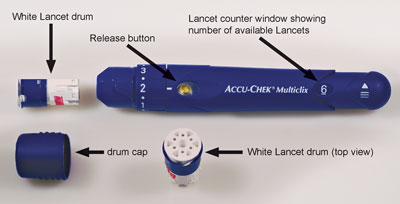Capillary Blood Sampling
Strategies for Preventing the Spread of Infectious Diseases and Accidental Injuries
 An Interview with Sharon M. Geaghan, MD
An Interview with Sharon M. Geaghan, MD
Capillary blood collection involves puncturing the dermis layer of the skin to access the capillary beds that run through the subcutaneous layer of the skin. While this collection method has been in use for many years, especially for blood glucose testing, transmission of hepatitis B virus from infected blood and accidental injuries is on the rise as the number of tests performed involving finger-stick devices expands. Here, Sharon M. Geaghan, MD, discusses how these infections and injuries occur and how to prevent them.
Dr. Geaghan is a professor of pathology and pediatrics at Stanford University School of Medicine in Palo Alto, Calif.
Nancy Sasavage, PhD, conducted this interview.
What patient safety risks are associated with capillary blood sampling?
The lancing devices used to obtain a small sample of capillary blood, typically from patients' fingers, pose two principal risks: transmission of infectious diseases between patients and injuries related to the puncture device used to obtain the blood. These risks are an important public health issue that healthcare workers who collect these samples need to understand in order to prevent the spread of infectious diseases. In fact, audits of hepatitis B outbreaks associated with capillary blood sampling have increased in frequency over the past 20 years, with some outbreaks resulting in patient deaths (1).
What is unique about the capillary blood sampling process that engenders these risks?
In finger-sticks, the blood flowing freely from the site of the puncture exposes both the healthcare worker taking the sample and the environment to blood-borne infectious agents that the patient may have. Venipuncture offers some protection because the blood is collected in stoppered, closed tubes via disposable needles designed with safety features. Nevertheless, one to several spills per 100 point-of-care testing events have been reported, some with substantial spatter (2), and healthcare workers under-report exposures, primarily because they believe that most exposures do not pose a significant risk (3). Even in an Iraq combat zone, data from an Air Force theater hospital showed that finger sticks were the highest risk activity for occupational exposure to blood and bodily fluids, representing more than 70% of all exposures.
How are the infectious agents transmitted?
Lancing patients' fingers or handling their glucose test strips exposes healthcare workers' hands to blood, even if they are wearing gloves. If healthcare providers do not use proper hand hygiene and change gloves between patients, transmission of diseases such as hepatitis B can occur (4).
What specific risks are associated with lancets and finger-stick devices?
Using these devices, especially spring-loaded devices, on multiple patients is one of the most serious risks to patients undergoing point-of-care testing. Both the Centers for Disease Control and Prevention (CDC) and the Food and Drug Administration now do not recommend using finger-stick devices on more than one patient.
Despite this recommendation, I have received many questions about cleaning and reusing devices on multiple patients. Institutions rationalize device reuse as a cost-saving measure; however, the association of this practice with outbreaks is clear, according to CDC's guidance. Finger-stick devices cannot be thoroughly disinfected, and the legal and medical costs of infectious disease transmission clearly outweigh any cost savings from reusing them.

Reusable finger-stick devices, such as this one,
present risks from blood contamination
and should not be used for multi-patient testing.
Why is the risk focused on hepatitis B?
It is the number one risk for patients undergoing point-of-care capillary sampling. Although significant bacterial pathogens also can be transmitted to patients directly or indirectly by equipment and cause clinically important disease, the primary focus on infection transmission linked to point-of-care testing is on viral diseases such as hepatitis B, hepatitis C, and HIV.
What makes hepatitis B the number one risk?
There are four reasons why hepatitis B has the highest risk of infection. First, the environmental stability of hepatitis B is legendary. The virus in dried blood on surfaces is known to remain infectious for a minimum of 7 days. Second, CDC estimates that the number of individuals with chronic hepatitis B is very large, somewhere between 800,000 and 1.4 million. Third, the titer of virus in an acutely infected patient is higher by an order of magnitude for hepatitis B than either hepatitis C or HIV. Finally, if exposure occurs, hepatitis B has an infectivity rate of approximately 30% compared with about 3% for hepatitis C and 0.2% for HIV.
Why are diabetics at increased risk for hepatitis B?
Diabetics, as a group, have more capillary blood sampling throughout the course of their disease than other patient groups. Therefore, over time, every diabetic patient with hepatitis B increases the risk of infection for other diabetics who may happen to be tested subsequently by the same healthcare worker who did not take the proper precautions.
Why do risks of capillary blood sampling affect diabetics, most of whom perform self-monitoring?
Diabetics also have assisted blood glucose monitoring as part of their spectrum of care, for example during acute hospitalizations or ambulatory care visits, in residential facilities, or at school or camp. In these settings, a caregiver performs the tests for the individual, which can lead to the transmission risks I described.
What can diabetics and other patients do to protect themselves?
Patients, like healthcare professionals, should take the following precautions. First, never share finger-stick devices—neither the instrument that punctures the skin nor the pen-like instrument that holds the lancet—with others, including friends and relatives. When in hospitals, clinics, ambulatory care centers and other settings where assisted monitoring is provided, make sure that healthcare workers use auto-disabling finger-stick devices designed to be used only once, after which the blade is retracted, capped, or otherwise made unusable.
Is it safe for patients in an institutional setting to perform their own blood glucose monitoring with a reusable finger-stick device?
Yes, it is, as long as the device is theirs and theirs alone. Safe practices recommended by the CDC include labeling multi-use devices with the patient's name and training patients on the safe use of the device, with specific attention to forbidding the patient to share it.
You mentioned that accidental puncture injuries also pose a health risk during capillary blood sampling. Could you elaborate?
Yes, injuries related to sharps, basically any medical device with sharp edges that are used to puncture or cut skin, are also an important occupational and public health issue.
What's the scope of injuries due to sharps?
CDC estimates annual sharps injuries and potential exposures to infectious pathogens to be as high as 385,000 among hospital workers alone (5).
What should individuals do if accidently stuck by a used sharp?
If you are accidentally stuck by a used sharp, you need to wash the exposed area immediately with soap and water or a skin antiseptic such as rubbing alcohol or hand sanitizer. You should also be evaluated without delay by your physician or local hospital.
What should individuals do about unsafe sharps practices that they observe in their workplace?
CDC offers a variety of free teaching resources as part of its Sharps Safety Awareness Program. The resources include: a workbook, Designing, Implementing and Evaluating a Sharps Injury Prevention Program, which is available as a CD or downloadable file; a set of slides with important points from the workbook, which can be used for staff presentations; and a printable brochure for healthcare professionals. A series of posters highlighting individual responsibility and the use of sharps with safety features are also available on the website.
How should sharps disposal be handled outside of hospital settings?
This is an important question because a large percentage of point-of-care testing occurs in settings other than hospitals. Furthermore, this segment of healthcare is expanding rapidly, and if it is not properly managed, the associated risks will increase. In addition, approximately 9 million Americans use sharps for blood sampling at home, generating 3 billion used sharps annually that require responsible disposal. One way to dispose of sharps safely is to use a recycling center. For example, Earth 911 offers a service on its website for locating needle disposal centers using your zip code.
REFERENCES
- Thompson ND, Perz JF. Eliminating the blood: Ongoing outbreaks of hepatitis B virus infection and the need for innovative glucose monitoring technologies. J Diab Sci Tech 2009;3:283–8.
- Janssens P. Widespread use of point-of-care testing is irreconcilable with the present-day quest for safety. Clin Chem Lab Med 2010;48:1527–8.
- Kessler CS, McGuinn M, Spec A, et al. Underreporting of blood and body fluid exposures among health care students and trainees in the acute care setting: A 2007 survey. Am J Infect Control 2011;39:129–34.
- Murray CK, Johnson EN, Conger NG, et al. Occupational exposure to blood and other bodily fluids at a military hospital in Iraq. J Trauma 2009;66:S62–8.
- Centers for Disease Control and Prevention. Sharps safety for healthcare settings. Go to the CDC website. (Accessed March 8, 2013).